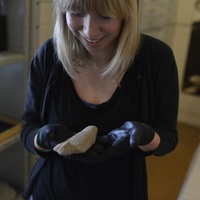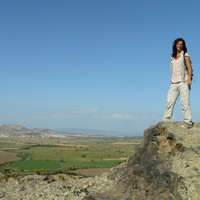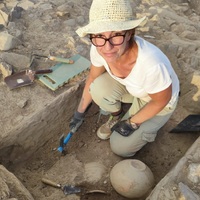
Athena Van der Perre
Currently involved in the following projects:
- Pyramids & Progress : Belgian Expansionism and the Making of Egyptology, 1830-1952 (EOS project 30885993)
Work Package 5: The main objective of WP5 is to trace the archaeological history of Egyptian antiquities in the collections of the RMAH (Brussels) and the Brooklyn Museum during Jean Capart’s term, and to clarify how the objects of these collections fit in the international excavations of their time. The very large scale British excavations produced contexted artefacts, which due to their dispersal have to a large extent lost their meaning. By tracing assemblages and linking them to the original excavation reports, the scientific importance of what are now essentially orphaned museum artefacts will be valorised. The WP will also aim to derive patterns in acquisition strategies.
The reconstruction of the archaeological contexts will be based on archival research at the museums, combined with personal documentation, excavation reports and diaries. The information gained during this research will be added to the online catalogues of the corresponding museums, and will contribute to a new permanent exhibition gallery at the RMAH which will be devoted to the history of Belgian Egyptology.
- SURA - Unlocking the Photographic Archives of the Pioneering Years of Egyptology at the Royal Museums of Art and History in Brussels (Brain-be 2.0)
SURA (Arabic for photo) is an interdisciplinary project that ties together Egyptology, digital imaging, archival studies and digital humanities to valorise an important but almost completely forgotten historical collection of glass plate photographs kept in the Egyptological library of the Royal Museums of Art and History (RMAH) in Brussels.
- The Limestone Quarries of Dayr Abu Hinnis (Dayr al-Barsha Project)
- Pixel+ & The Portable Light Dome (KU Leuven)
- Pyramids & Progress : Belgian Expansionism and the Making of Egyptology, 1830-1952 (EOS project 30885993)
Work Package 5: The main objective of WP5 is to trace the archaeological history of Egyptian antiquities in the collections of the RMAH (Brussels) and the Brooklyn Museum during Jean Capart’s term, and to clarify how the objects of these collections fit in the international excavations of their time. The very large scale British excavations produced contexted artefacts, which due to their dispersal have to a large extent lost their meaning. By tracing assemblages and linking them to the original excavation reports, the scientific importance of what are now essentially orphaned museum artefacts will be valorised. The WP will also aim to derive patterns in acquisition strategies.
The reconstruction of the archaeological contexts will be based on archival research at the museums, combined with personal documentation, excavation reports and diaries. The information gained during this research will be added to the online catalogues of the corresponding museums, and will contribute to a new permanent exhibition gallery at the RMAH which will be devoted to the history of Belgian Egyptology.
- SURA - Unlocking the Photographic Archives of the Pioneering Years of Egyptology at the Royal Museums of Art and History in Brussels (Brain-be 2.0)
SURA (Arabic for photo) is an interdisciplinary project that ties together Egyptology, digital imaging, archival studies and digital humanities to valorise an important but almost completely forgotten historical collection of glass plate photographs kept in the Egyptological library of the Royal Museums of Art and History (RMAH) in Brussels.
- The Limestone Quarries of Dayr Abu Hinnis (Dayr al-Barsha Project)
- Pixel+ & The Portable Light Dome (KU Leuven)
less
Related Authors
Aaron A Burke
University of California, Los Angeles
James Elkins
School of the Art Institute of Chicago
Elif SERTEL
Istanbul Technical University
Christina Williamson
University of Groningen
Maurizio Forte
Duke University
Marta Diaz-Guardamino
Durham University
João Fonte
University of Exeter
Maria Nilsson
Lund University
Enrico Cirelli
Università di Bologna
Barry Molloy
University College Dublin
InterestsView All (41)










Uploads
Journal papers by Athena Van der Perre
The MS PLD system has been tested for research ranging from medieval manuscript illuminations to ancient Egyptian artefacts. Preliminary results have shown it documents and measures the 3D surface structure of objects, re-visualises underdrawings, faded pigments and inscriptions, and examines the MS results in combination with the actual relief characteristics of the physical object. Newly developed features are reflection maps and histograms, analytic visualisations of the reflection properties of all separate LEDs or selected areas. In its capacity as imaging technology, the system acts as a tool for the analysis of surface materials (e.g. identification of blue pigments, gold and metallic surfaces). Besides offering support in answering questions of attribution and monitoring changes and decay of materials, the PLD also contributes to the identification of materials; all essential factors when making decisions in the conservation protocol.
Akhenaten proves that Akhenaten and Nefertiti were still the royal couple near the
end of his reign. It is the highest known date of Queen Nefertiti and the latest dated
inscription which can be certainly attributed to Akhenaten himself. The second part of
the article evaluates current theories concerning the final years of Nefertiti and the
successors of Akhenaten in the light of the new text.
Book chapters and proceedings by Athena Van der Perre
Capart was not only a great scholar, as the first curator of the Egyptian department he also managed to enlarge the Brussels collection in a monumental way. Between 1900 and 1947, thousands of artefacts entered the museum, making it the largest Egyptological collection of Belgium. Some of the masterpieces were lucky finds, such as the relief of queen Tiye, while others required a lot of effort and negotiations, e.g. the mastaba of Neferirtenef. The majority of the objects, however, can be directly linked to British excavations. This paper focuses on the provenance of the objects from these excavations.
The research was conducted within the framework of the EOS Project “Pyramids & Progress. Belgian Expansionism and the Making of Egyptology, 1830-1952”.
The MS PLD system has been tested for research ranging from medieval manuscript illuminations to ancient Egyptian artefacts. Preliminary results have shown it documents and measures the 3D surface structure of objects, re-visualises underdrawings, faded pigments and inscriptions, and examines the MS results in combination with the actual relief characteristics of the physical object. Newly developed features are reflection maps and histograms, analytic visualisations of the reflection properties of all separate LEDs or selected areas. In its capacity as imaging technology, the system acts as a tool for the analysis of surface materials (e.g. identification of blue pigments, gold and metallic surfaces). Besides offering support in answering questions of attribution and monitoring changes and decay of materials, the PLD also contributes to the identification of materials; all essential factors when making decisions in the conservation protocol.
Akhenaten proves that Akhenaten and Nefertiti were still the royal couple near the
end of his reign. It is the highest known date of Queen Nefertiti and the latest dated
inscription which can be certainly attributed to Akhenaten himself. The second part of
the article evaluates current theories concerning the final years of Nefertiti and the
successors of Akhenaten in the light of the new text.
Capart was not only a great scholar, as the first curator of the Egyptian department he also managed to enlarge the Brussels collection in a monumental way. Between 1900 and 1947, thousands of artefacts entered the museum, making it the largest Egyptological collection of Belgium. Some of the masterpieces were lucky finds, such as the relief of queen Tiye, while others required a lot of effort and negotiations, e.g. the mastaba of Neferirtenef. The majority of the objects, however, can be directly linked to British excavations. This paper focuses on the provenance of the objects from these excavations.
The research was conducted within the framework of the EOS Project “Pyramids & Progress. Belgian Expansionism and the Making of Egyptology, 1830-1952”.
This paper presents the project’s first preliminary results.
The Egyptian collection of the Royal Museums of Art and History (RMAH Brussels) contains a large number of small decorated and/or inscribed objects. Some of these objects are currently in a bad condition - any operation carried on them can result in considerable material losses -, making it necessary to document them in such a way that it allows future scholars to study them in detail without handling them. The EES Project therefore aims to create multispectral 3D images of these fragile objects with a multispectral ‘minidome’ acquisition system, based on the already existing system of the multi-light Portable Light Dome (PLD). The texture/colour values on the created 2D+ and 3D models are interactive data based on a recording process with infrared, red, green, blue, and ultraviolet light spectra. Software tools and enhancement filters have been developed which can deal with the different wavelengths in real-time. This leads to an easy and cost-effective methodology which combines multispectral imaging with the actual relief characteristics and properties of the physical object. The system is transportable to any collection or excavation in the field.
As a case study, the well-known Brussels “Execration Figurines” (Middle Kingdom, c. 1900 BC) were chosen. These figurines are made of unbaked clay and covered with hieratic texts, listing names of foreign countries and rulers. The study of this type of collections is mostly hampered by the poor state of conservation of the objects, but also by the only partial preservation of the ink traces in visible light. The method has also been applied to other decorated objects of the RMAH collection, such as a Fayoum portrait, ostraca and decorated objects made of stone, wood and ceramics. The final goal will be to publish the newly created multispectral 3D images on Carmentis (www.carmentis.be), the online catalogue of the RMAH collection, making them accessible to scholars all over the world.
The second case study presents the quarry inscriptions of the New Kingdom limestone quarries at Dayr Abu Hinnis (Middle Egypt). These gallery quarries contain hundreds of hieratic inscriptions, written on the ceiling. The texts are mainly related to the general administration of the quarry area. In documenting the abundance of ceiling inscriptions and other graffiti, we had to decide upon a practice that would allow not only to capture the "content", but also to document the location and orientation of each record. Every inscription can be photographed in detail, but this is insufficient to provide the reader access to vital information concerning the spatial distribution of the inscriptions, which may, for instance, relate to the progress of work.
After experimenting with a variety of other methods, we adopted a photogrammetric software for 3D modelling photographs of the quarry ceilings, AGISOFT PHOTOSCAN, which uses structure from motion (SFM) algorithms to create three-dimensional images based on a series of overlapping two-dimensional images.
The ultimate goal of this whole labour-intensive process in the quarries is not the creation of pure three-dimensional models, but rather to generate an orthophoto of the entire ceiling of a quarry. Based on these images, each graffito could be analysed in context.
Athena Van der Perre
The Egyptian Execration Statuettes (EES) Project (RMAH Brussels)
Dayr al-Barsha Project (KU Leuven)
athena.vanderperre@gmail.com, a.vanderperre@kmkg-mrah.be
For more information and (first) preliminary results, see:
http://www.kmkg-mrah.be/conservation-ir-uv-and-3d-imaging-egyptian-execration-statuettes
https://portablelightdome.wordpress.com/2015/05/06/first-preliminary-results-of-the-egyptian-execration-statuettes-ees-project/
The EES project is financed by Belspo Brain-be Pioneer: BR/121/PI/EES
The Egyptian collection of the RMAH comprises about one hundred execration figurines made of unbaked clay, bearing curses written in hieratic script (a cursive writing system related to hieroglyphs) and dating to the Middle Kingdom (c. 1850 BC). These represent captured (foreign) enemies and were buried ritually in order to symbolically neutralise foreign and domestic enemies and general threats. Nearly 90 years after their discovery, the red and black pigments used to inscribe these four millennia old objects are now faded or damaged. The Execration texts on these figurines are regarded as one of the most renowned collections of written sources for ancient Near Eastern studies, Egyptian history and Biblical studies for the early 2nd millennium BCE. When it comes to documenting every characteristic of an object in a highly detailed way, clay artefacts inscribed with ink and other pigments, such as the aforementioned figurines, pose a particular challenge. These three-dimensional media with curved surfaces hold traces of writing that, in some cases, have faded or have disappeared completely. The study of these objects is generally hampered by their poor state of conservation, any handling can result in a considerable loss of material (and therefore also valuable information). The EES project aimed to develop new imaging techniques (using interactive 2D, 3D and multispectral images) that can improve the legibility of faded inscriptions and enhance the decorations on clay objects. Combining 3D digitisation and multispectral imaging in a userfriendly and transportable system, that is also manageable by curators, conservators, researchers and other stakeholders in the museum, is a truly pioneering project. It must facilitate the management of recorded collections and offer numerous possibilities for historical and art-technical studies on these objects, while the future handling is limited to a minimum, thus ensuring their sustainability.
The first chapter gives an overview of the building history of Amarna, and describes the use of limestone in the city. The development of talatat blocks is discussed, as is the known information on Amarna period quarries in general. The chapter continues with a description of the greater Dayr al-Barsha region, including topography, geography and previous research. At last, the methodology and objectives of this study are discussed.
In the second chapter, the focus lies on the quarry as a production unit. The exploitation techniques of the Amarna period are described and compared to previous and later exploitation phases. One of the most important results is the creation of a chisel mark typology, which enabled the identification of Amarna period quarries based on the remaining chisel marks. This chapter also describes the logistics and infrastructure connected to a quarry area.
A quarry ceiling appeared to be the favourite place of the scribes for keeping their administrative notes. Hundreds of hieratic inscriptions, combined with lines, drawings and non-textual marking systems, refer to the work progress, the destination of the quarried stones and the general organisation of a quarry unit. A comprehensive overview of the different types of inscriptions and markings can be found in the third chapter.
Since the total amount of gallery quarries at the area is over 400, it was not possible to describe these all in detail. Therefore, a selection of 10 representative quarries was made. The detailed description of these quarries can be found in chapter 4. The abundance of inscriptions, and the fact that their relative position was important for the study of the general organisation, made it impossible to use the standard documentation methods. 3D ceiling maps were created, based on hundreds of photos, with the help of photogrammetric software. These maps have been added to the thesis in the Appendices.
The last chapter describes the most remarkable inscription of the area. On a pillar in the back of Quarry 320, a building inscription was written. The most important part of the inscription is in fact the date. The text is dated to the 16th regnal year of Akhenaten and adds important information to the history of the city and its rulers. Nefertiti is still mentioned as the Chief King’s Wife, so this not only proves that she was still alive, but also that the royal couple still reigned together. It also shows that significant construction works were still taking place at the end of Akhenaten’s reign.
At last, the general conclusions are given, followed by the appendices.
Supervisor: Prof. Dr. Harco Willems
Co-Supervisor: Dr. Jacobus van Dijk
De tumultueuze periode waarin ze leefde, én vooral de damnatio memoriae na haar dood, zorgen ervoor dat onze kennis over haar leven vandaag nog steeds zeer beperkt is. Hierdoor was ze een gedroomd onderwerp voor talrijke verzinsels en speculaties. Recent onderzoek bracht echter een aantal nieuwe, verrassende feiten aan het licht. Hieruit blijkt dat Nefertiti meer was dan alleen een mooi snoetje, maar dat ze zelf een aantal belangrijke touwtjes in handen had. Na het overlijden van haar echtgenoot, de zogenaamde ketterkoning Echnaton, zou ze zelf de troon bestijgen en gedurende een korte periode heersen over Egypte. Over de periode na haar dood zijn nog steeds talloze vragen onbeantwoord gebleven. Wat gebeurde er met Semenkhkare, de gedoodverfde troonopvolger? Hoe past Toetanchamon in dit hele verhaal? En vooral, waar is Nefertiti nu?
Tijdens deze lezing gaat egyptologe Athena Van der Perre in op de recente ontwikkelingen in het onderzoek naar deze bekende koningin en weerlegt ze een aantal van de gangbare theorieën over haar leven en dood.
Recent wetenschappelijk onderzoek, waarin egyptologe Athena Van der Perre een belangrijke rol speelde, bracht een aantal nieuwe en verrassende feiten aan het licht. Zo blijkt dat Nefertiti niet langer als een - weliswaar mooi - leeghoofdje kan beschouwd worden, maar dat ze zelf de touwtjes in handen had. Ze zou uiteindelijk zelfs de troon bestijgen na het overlijden van haar echtgenoot. Dat beeld staat in schril contrast met de gangbare opinie die meent dat Echnaton na zijn dood gedurende een zeer korte periode werd opgevolgd door een zekere Semenkhkare, die op zijn beurt werd opgevolgd door de kind-koning Toetanchamon. In dat verhaal speelde Nefertiti slechts een bescheiden bijrolletje.
Athena Van der Perre gaat tijdens deze lezing in op de recentste ontwikkelingen in het onderzoek naar de zogenaamde Amarna-dynastie en beantwoordt zoveel mogelijk vragen over de mooie koningin Nefertiti.
Based on the results of a preliminary imaging session on a decorated 21st Dynasty coffin at the RMAH, this paper will present the specifications of the method, the advantages and limitations of this interactive MS 3D approach, and the potential for future applications of the MS PLD system. Furthermore, beside colour, texture and shape, the results allow to analyse the reflective properties of the registered pigments and materials.
Archeologische en tekstuele bronnen tonen aan dat zogenaamde execratie- of verwensingsrituelen uitgevoerd werden doorheen de Egyptische geschiedenis. De vroegste varianten van het ritueel dateren uit het Oude Rijk, de meest recente uit de 14e eeuw na Chr. Wat echter niet algemeen bekend is, is dat een van de belangrijkste assemblages van verwensingsbeeldjes, daterend uit het Middenrijk (ca. 1850 v. Chr.), zich bevindt in de Egyptische collectie van het Jubelparkmuseum (KMKG Brussel).
De figurines, gemaakt uit ongebakken klei, zijn beschreven met hiëratische teksten die de vijanden van Egypte opsommen. Aangezien hier verwezen wordt naar volkeren en steden uit Azië, Nubië en Libië, vormen deze objecten een zeer belangrijke bron voor de reconstructie van de politieke antieke geografie van het Nabije Oosten in de 12e dynastie.
De voorbije twee jaar waren deze beeldjes de protagonisten van het Egyptian Execration Statuettes (EES) Project. Hoewel het hoofddoel van het project de ontwikkeling van een multispectraal 3D-beeldvormingssysteem was, werd een aanzienlijk deel van de tijd besteed aan diepgaand onderzoek naar de figurines. De laatste resultaten van het project komen dan ook uitgebreid aan bod in deze lezing.
Dit onderzoek kadert binnen het EES Project van de KMKG, gefinancierd door Belspo Brain-be Pionier BR/121/PI/EES (Coördinator Luc Delvaux, co-coördinator Hendrik Hameeuw).
De Egyptische collectie van het Jubelparkmuseum bevat een grote groep verwensingsbeeldjes uit het Middenrijk (ca. 1850 v. Chr.). Deze figurines, gemaakt uit ongebakken klei, zijn beschreven met hiëratische teksten die de vijanden van de farao opsommen. Aangezien hier verwezen wordt naar volkeren en steden uit Azië, Nubië en Libië, vormen deze objecten een zeer belangrijke bron voor de reconstructie van de politieke antieke geografie van het Nabije Oosten.
Deze lezing zal eveneens de resultaten bespreken van het Egyptian Execration Statuettes (EES) Project. Het hoofddoel van dit project is de creatie van multispectrale 3D-beelden van een serie fragiele Egyptische objecten uit de KMKG collectie. De eerder vermelde verwensingsbeeldjes werden uitgekozen als testgroep.
As a case-study, the well-known Brussels “Execration Statuettes” (Middle Kingdom, ca. 1900 BC) have been chosen. Their surface is covered with hieratic texts, written in two types of ink (black carbon and red ochre), listing names of foreign countries and places. The study of this type of collections is mostly hampered by the poor state of conservation of the objects (in this case unbaked crude clay) - any operation carried on them can result in considerable material losses - and
secondly, by the only partial preservation of the ink traces in visible light. Thus, creating an approach which requires minimal handling but delivers maximal output for research and
conservation purposes must be seen as most welcoming. In addition, the system presents itself as an easy by scholars to use tool and transportable to any collection or excavation in the field. This project is financed by the Belgian Science Policy (Belspo): BRAIN.be.
This lecture will focus on the first preliminary results of the project.
The EES (Egyptian Execration Statuettes) Project aims to create multi-spectral 3D images of a series of fragile Egyptian objects of the Royal Museums of Art and History collection (Brussels) in order to avoid future handling and facilitate their detailed study.
The texture/colour values on these 2D+ and 3D models are interactive data based on a recording process with infrared, red, green, blue and ultraviolet light spectra. The main device, a multispectral ‘minidome’ acquisition system, is based on the already existing system of the multi-light Portable Light Dome (PLD). Software tools and enhancement filters have been developed which can deal with the different wavelengths in real-time. They ensure the multi-spectral 3D digitalization and visualization of fragile objects, bearing inscriptions or pigments on ostraca, tablets, papyri, etc.; all preserved on/in clay, wood, stone, parchment, papyrus or paper. This leads to an easy and cost-effective methodology which combines multi-spectral imaging with the actual relief characteristics and properties of the physical object; thanks to the use of the multi-light reflectance approach of the PLD system. In addition, creating an set-up which requires minimal handling but delivers maximal output for research and conservation purposes, must be seen as most welcoming in working with fragile objects. The system presents itself as an easy by scholars to use tool and transportable to any collection or excavation in the field. This project is financed by Belspo Brain-be Pioneer: BR/121/PI/EES.
Keywords: multispectral 3D-imaging, photometric stereo, conservation, documentation, ancient inscriptions
Deze lezing zal zich niet enkel toespitsen op de vernieuwende technieken die aangetroffen worden in de steengroeven, maar ook op de historische achtergrond van de belangrijkste exploitatiefase. De ontginning van talatat-blokken zorgde voor een kentering binnen het bestaande productie- en transportsysteem. De honderden inscripties kunnen beschouwd worden als een van de belangrijkste bronnen, maar ze bevatten meer dan alleen werkgerelateerde informatie. De invloed van de Amarna kunstenaars is vaak zichtbaar.
Maar waren de steenkappers van Echnaton de enige die werkzaam waren in het gebied? De ontdekking van Ramessidische inscripties bewijst het tegendeel. Ook in de Late Tijd en de Romeinse/Vroegchristelijke periode werd het gebied intensief gebruikt.
The pharaonic limestone quarry complex of Dayr Abu Hinnis (Middle Egypt, ca. 1350 BC) presents the investigating egyptologist with a set of original problems. The ceilings of these vast subterranean quarries, some of which have a depth of nearly 100m, are covered in graffiti, quarry marks, and inscriptions of the ancient quarrymen. These inscriptions frequently include dates through which the exploitation of the quarry can be followed chronologically. Other features of interest are clusters of non-textual marks and historic inscriptions. Traditional methods to document the position of these elements are inadequate, as they can only cover small individual parts and never the entire quarry ceiling. Therefore we searched for a new methodology to map these vast areas. After a few trials and errors with different software packages, we finally landed on Agisoft PhotoScan. The methodology, advantages, and challenges that this approach offers, will be discussed. In addition to the quarries, we also applied the same technique to other archaeological features.